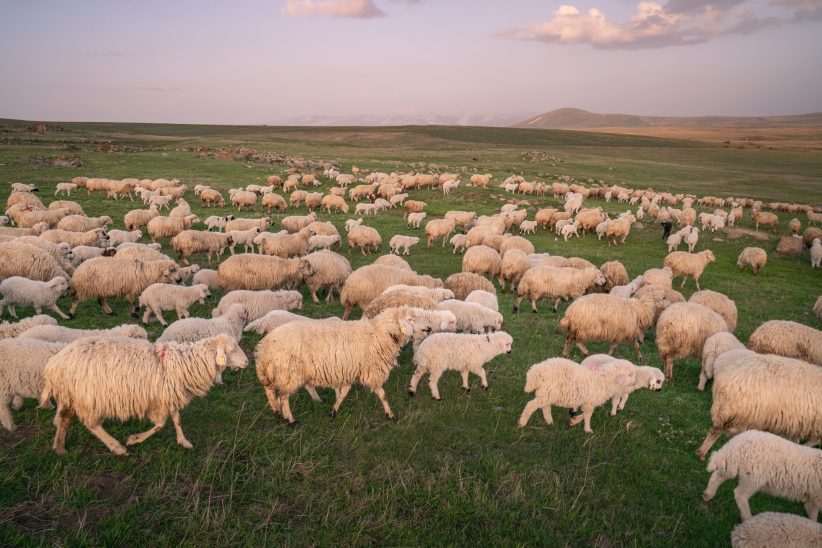By Paul Vartan Sookiasian
At the end of a dirt road at the top edge of Armenia’s northeastern Shirak region lies a tiny village seeking to bring big changes to Armenia’s wool industry. Darik has a population of just three people, but what it lacks in people, it makes up for in about 1,600 sheep, all raised at a farm run by husband-and-wife duo Armen Khechoyan and Ira Tadevosyan.
The majority of sheep in Armenia, including in Darik, are raised for their meat, with most of their wool going unused, often burned or simply thrown away. That untapped potential has inspired a new effort by the Homeland Development Initiative Foundation (HDIF), a Yerevan-based job creation organization, to upgrade Armenia’s entire wool value chain, starting from Darik. The goal, according to HDIF’s founder Tim Straight, is to create better paying jobs and produce higher quality products.
“We want to maximize what is possible using Armenian wool and sell it for the highest possible price to customers who will pay a higher price, because we document every step of the value chain under a blockchain system,” Straight, who also serves as the project lead, told CivilNet in Darik.
That value chain includes raising sheep, shearing them in a way that prioritizes health and safety and maximizes the wool’s value, washing and carding the wool and then spinning it into high-value and high-quality yarn, dying the yarn using local products, and then weaving rugs and carpets, of both traditional and modern design. Wool felting is also a growing industry in Armenia, Straight said, and could also make use of the new, higher quality materials that are expected to come out of the project.
But it all starts in Darik. Armen and Ira said they first came to this remote corner of Armenia 30 years ago “just to get away from it all.” The small village was empty, as its former population of Karapapakh Turks left in 1988 due to intercommunal tensions sparked by the Nagorno-Karabakh conflict. The ruins of their homes, damaged by the earthquake that struck later that year, watch over the farm.
Despite the impossibly cold winters in Darik, which sees meters of snow and temperatures drop to -40, the Khechoyans have created a very special kind of farm, dedicated to raising native Armenian animal species, like Van cats and Gampr dogs, as well as sheep.
“We want all our animals to be from pure Armenian breeds. That’s why we raise native Balbas sheep, which are adapted to live in this cold, mountainous terrain,” the couple’s son, Vahagn Khechoyan, told CivilNet.
Now these native Armenian sheep are serving as the base of HDIF’s new program to modernize shearing practices. For that, the foundation brought in Scottish shearing expert Robbie Hislop to Armenia to pass on his knowledge of new techniques and technologies that can help ensure greater efficiency.
“The most important thing I am here to do is instruct the shearers to get the wool off in one solid fleece. Cutting wool off properly makes it more valuable, and it can be used down the line for a number of uses, like clothing or insulation, in addition to traditional products like rugs and carpets and be better for the economy,“ Hislop told CivilNet.

To that point, HDIF’s initiative also seeks to use wool to bolster local cultural heritage and economies, as wool plays an integral role in Armenia’s centuries-old rug-weaving tradition. That is why representatives of local carpet companies have also visited Darik, to see how the planned wool upgrades could help their mission of reviving Armenia’s ancient rug-making tradition.
“We never want to use imported wool, so projects like this are really important to ensure that we can source high-quality wool that’s sourced locally, hand-spun locally, and dyed locally using natural materials”, explained Kyle Khandikian, founder of The Rug Code, a new online store designing hand-woven Armenian carpets.
Also watch: Reviving the art of the Armenian rug
In addition, HDIF’s project also envisages analyzing the wool to determine the best ways it can be used for export.
That is important since Armenia’s government last year earmarked $35 million to support the country’s textile industry, one of 11 designated “strategic sectors with significant export potential.” The government says it expects the support program to boost annual textile exports to over $500 million within the next three years.
At present, textile companies employ about 11,000 people in Armenia. Nine out of 10 textile workers are women, providing an important source of employment in a country with a significant and persistent gender gap in labor participation rates.
To that end, HDIF hopes overhauling Armenia’s wool value chain can help create new economic opportunities in rural communities, while also enhancing the quality of Armenian wool through innovation and sustainability.

















2 Comments
Thank you for a very informative article and kudos to HDIF and Tim Straight for their different initiatives.
I am wondering how HDIF will be able to export wool, when the wool market is in a slump and sheep wool producers in France are dumping their wool in the garbage (some are making insulation material with it).
Very good development and initiatives. I hope you will achieve your objectives.